Top Rankings
Hancock Public School District ranks among the top 20% of public school district in Minnesota for:
Category
Attribute
Overall Rank
Highest overall rank (Top 5%)
Math Proficiency
Highest math proficiency (Top 5%)
Reading/Language Arts Proficiency
Highest reading/language arts proficiency (Top 10%)
Science Proficiency
Highest science proficiency (Top 10%)
For the 2025 school year, there are 2 public schools serving 434 students in Hancock Public School District. This district's average testing ranking is 10/10, which is in the top 5% of public schools in Minnesota.
Public Schools in Hancock Public School District have an average math proficiency score of 66% (versus the Minnesota public school average of 45%), and reading proficiency score of 65% (versus the 51% statewide average).
Minority enrollment is 15% of the student body (majority Hispanic), which is less than the Minnesota public school average of 39% (majority Black and Hispanic).
Overview
This School District
This State (MN)
# Schools
2 Schools
2,732 Schools
# Students
434 Students
870,790 Students
# Teachers
34 Teachers
57,779 Teachers
Student : Teacher Ratio
13:1
13:1
District Rank
Hancock Public School District, which is ranked within the top 5% of all 522 school districts in Minnesota (based off of combined math and reading proficiency testing data) for the 2021-2022 school year.
The school district's graduation rate of 80% has stayed relatively flat over five school years.
Overall District Rank
#22 out of 527 school districts
(Top 5%)
(Top 5%)
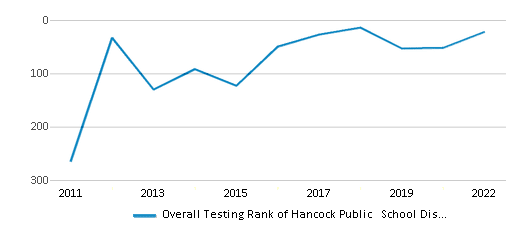
Math Test Scores (% Proficient)
66%
45%
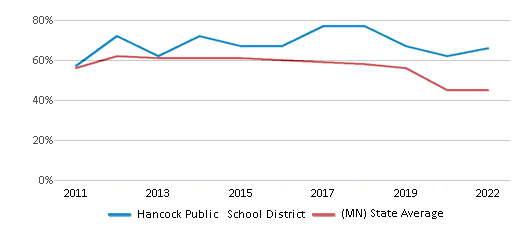
Reading/Language Arts Test Scores (% Proficient)
65%
51%
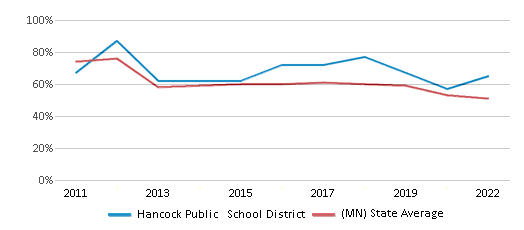
Science Test Scores (% Proficient)
55%
41%
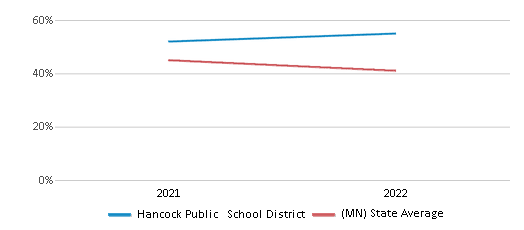
Graduation Rate
≥80%
84%

Students by Ethnicity:
Diversity Score
0.27
0.59
# American Indian Students
n/a
15,699 Students
% American Indian Students
n/a
2%
# Asian Students
n/a
61,819 Students
% Asian Students
n/a
7%
# Hispanic Students
47 Students
99,588 Students
% Hispanic Students
11%
12%
# Black Students
2 Students
102,736 Students
% Black Students
n/a
12%
# White Students
369 Students
534,612 Students
% White Students
85%
61%
# Hawaiian Students
n/a
1,007 Students
% Hawaiian Students
n/a
n/a
# Two or more races Students
16 Students
55,329 Students
% of Two or more races Students
4%
6%
Students by Grade:
# Students in PK Grade:
-
24,648
# Students in K Grade:
28
59,654
# Students in 1st Grade:
33
61,859
# Students in 2nd Grade:
27
63,560
# Students in 3rd Grade:
41
61,751
# Students in 4th Grade:
34
63,575
# Students in 5th Grade:
30
63,290
# Students in 6th Grade:
34
63,180
# Students in 7th Grade:
35
63,243
# Students in 8th Grade:
37
64,723
# Students in 9th Grade:
31
67,716
# Students in 10th Grade:
37
69,634
# Students in 11th Grade:
31
69,942
# Students in 12th Grade:
36
74,015
# Ungraded Students:
-
-
District Revenue and Spending
The revenue/student of $14,378 in this school district is less than the state median of $17,854. The school district revenue/student has declined by 5% over four school years.
The school district's spending/student of $14,468 is less than the state median of $18,580. The school district spending/student has declined by 5% over four school years.
Total Revenue
$6 MM
$15,547 MM
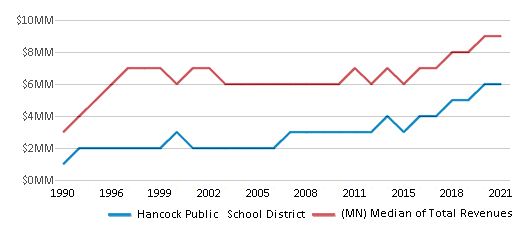
Spending
$6 MM
$16,179 MM
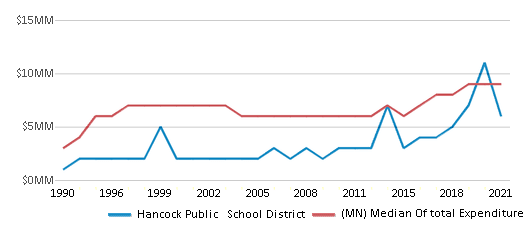
Revenue / Student
$14,378
$17,854
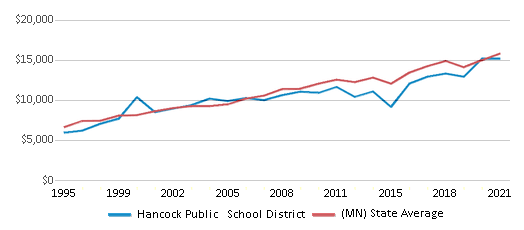
Spending / Student
$14,468
$18,580
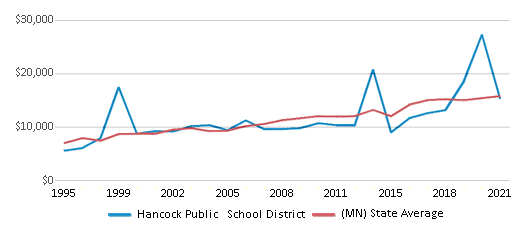
Best Hancock Public School District Public Schools (2025)
School
(Math and Reading Proficiency)
(Math and Reading Proficiency)
Location
Grades
Students
Rank: #11.
Hancock Elementary School
(Math: 75-79% | Reading: 70-74%)
Rank:
Rank:
10/
Top 5%10
371 Hancock Ave
Hancock, MN 56244
(320) 392-5622
Hancock, MN 56244
(320) 392-5622
Grades: PK-6
| 227 students
Rank: #22.
Hancock Secondary School
(Math: 50-54% | Reading: 55-59%)
Rank:
Rank:
8/
Top 30%10
371 Hancock Ave
Hancock, MN 56244
(320) 392-5622
Hancock, MN 56244
(320) 392-5622
Grades: 7-12
| 207 students
Frequently Asked Questions
How many schools belong to Hancock Public School District?
Hancock Public School District manages 2 public schools serving 434 students.
What is the rank of Hancock Public School District?
Hancock Public School District is ranked #22 out of 522 school districts in Minnesota (top 5%) based off of combined math and reading proficiency testing data for the 2021-2022 school year. This district ranks in the top 20% of Minnesota school districts for: Highest overall rank (Top 5%), Highest math proficiency (Top 5%), Highest reading/language arts proficiency (Top 10%) and Highest science proficiency (Top 10%)
What is the racial composition of students in Hancock Public School District?
85% of Hancock Public School District students are White, 11% of students are Hispanic, and 4% of students are Two or more races.
What is the student/teacher ratio of Hancock Public School District?
Hancock Public School District has a student/teacher ratio of 13:1, which is lower than the Minnesota state average of 15:1.
What is Hancock Public School District's spending/student ratio?
The school district's spending/student of $14,468 is less than the state median of $18,580. The school district spending/student has declined by 5% over four school years.
Recent Articles

What Is A Charter School?
Explore the world of charter schools in this comprehensive guide. Learn about their history, how they operate, and the pros and cons of this educational innovation. Discover key facts about charter schools, including admission policies, demographics, and funding, as well as what to look for when considering a charter school for your child.

10 Reasons Why High School Sports Benefit Students
Discover the 10 compelling reasons why high school sports are beneficial for students. This comprehensive article explores how athletics enhance academic performance, foster personal growth, and develop crucial life skills. From improved fitness and time management to leadership development and community representation, learn why participating in high school sports can be a game-changer for students' overall success and well-being.

February 05, 2025
Understanding the U.S. Department of Education: Structure, Impact, and EvolutionWe explore how the Department of Education shapes American education, from its cabinet-level leadership to its impact on millions of students, written for general audiences seeking clarity on this vital institution.





